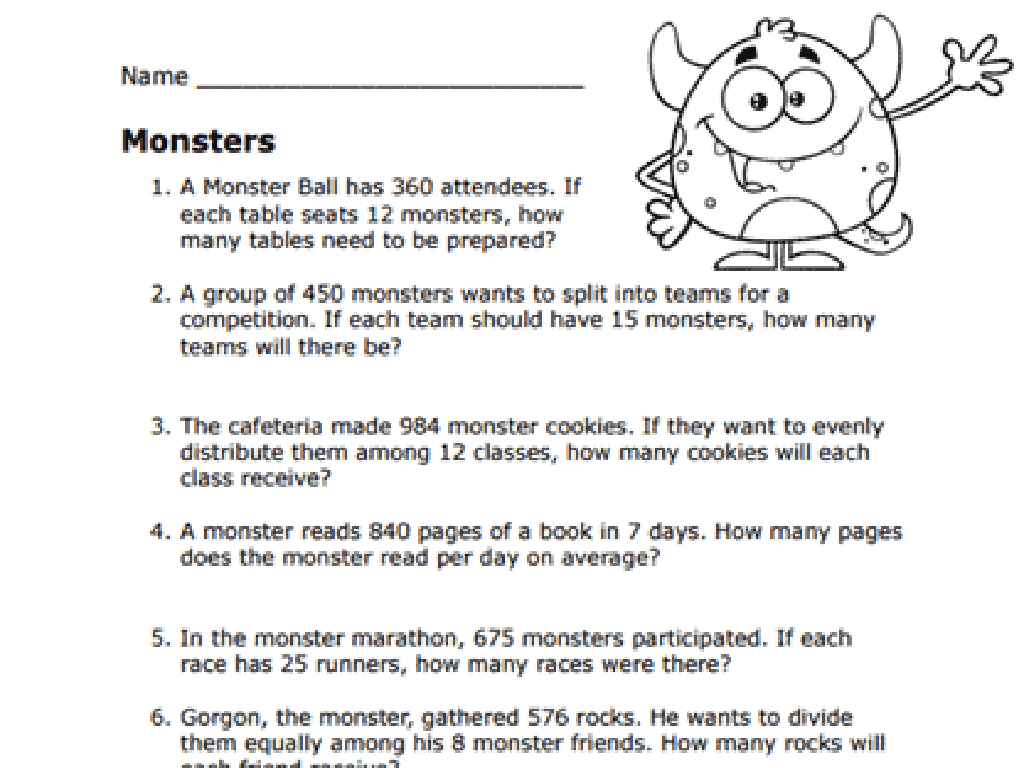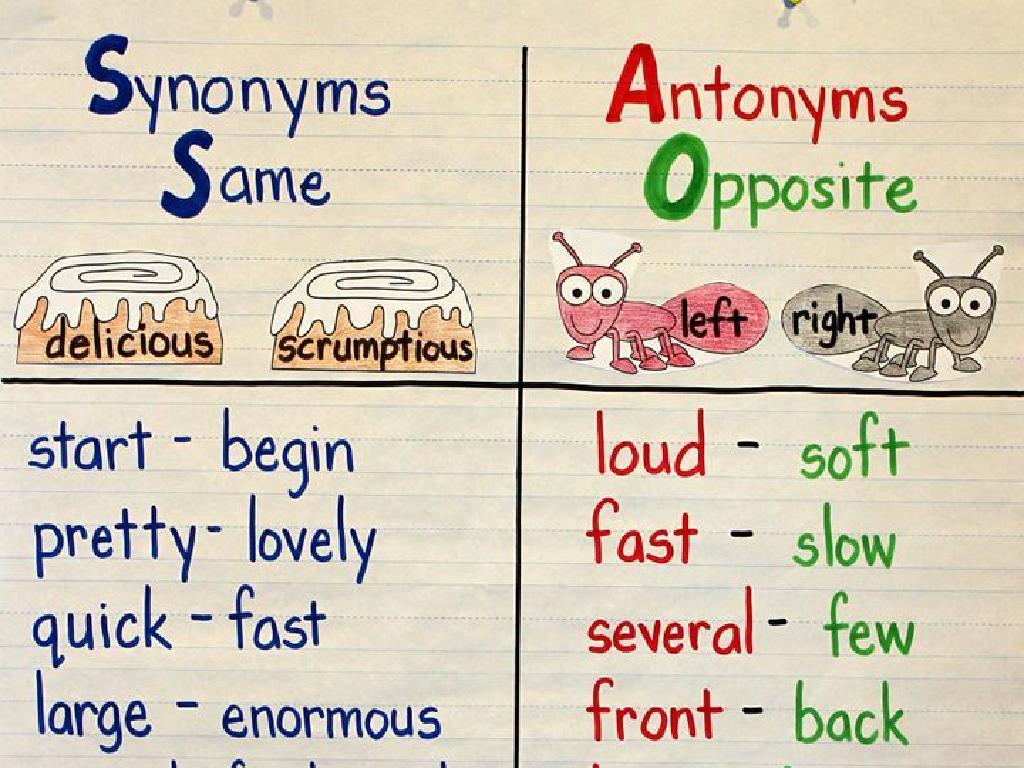Read Drama
Subject: Language arts
Grade: Fifth grade
Topic: Literary Texts: Level 2
Please LOG IN to download the presentation. Access is available to registered users only.
View More Content
Introduction to Drama
– What is drama?
– Drama is a unique form of storytelling through performances.
– Drama in plays and performances
– Explore how plays are acted out for an audience.
– Bringing stories to life
– Understand the transformation from script to stage action.
– The magic of the stage
|
This slide introduces students to the concept of drama as a storytelling medium that is performed rather than read. Drama involves plays and performances where actors bring characters and narratives to life in front of an audience. It’s important to convey the excitement and creativity involved in transforming a written script into a live performance. Encourage students to think about how characters, dialogue, and stage directions in a script contribute to the overall experience of a play. Discuss the collaborative effort between actors, directors, and crew to create the magic that the audience sees on stage. You can also mention famous plays and invite students to share if they have seen any play or performance.
Exploring the Elements of Drama
– Characters: Soul of the drama
– Think of characters like friends in a story.
– Plot: The unfolding story
– It’s the sequence of events that happen.
– Setting: Time and place
– Setting is like the backdrop of a play, it tells us where and when the story is happening.
– Dialogue: Character conversations
– What the characters say to each other.
– Stage Directions: Performance guide
– These are special instructions that tell the actors what to do and how to move on stage.
|
This slide introduces the fundamental elements of drama to the students. Characters are the individuals in the play, and they are crucial as the audience connects with them emotionally. The plot is the storyline, and it’s important for students to understand the beginning, middle, and end structure. The setting provides context for the drama, giving clues about the environment and time period. Dialogue is the spoken words between characters, which drives the action and reveals their personalities and relationships. Stage directions are crucial for the actors and crew to bring the script to life with movements and expressions. Encourage students to identify these elements when they read a play. You can have them act out scenes to understand stage directions better and discuss how different settings might change the story.
Reading a Script: Drama Exploration
– Parts of a script: cast, dialogue, directions
– Cast list names characters, dialogue is spoken words, stage directions tell actors what to do
– Reading character lines and cues
– Learn to spot your character’s lines and when to speak
– Expressive reading for characters
– Use tone and emotion to bring the character to life
– Why expression matters in drama
– Expression helps convey the story and emotions to the audience
|
This slide introduces students to the structure of a script and the basics of reading drama. Begin by explaining the different parts of a script, including the cast list, which outlines the characters; the dialogue, which are the words the characters speak; and the stage directions, which instruct actors on their physical actions. Emphasize the importance of understanding cues, which signal when a character should speak or act. Teach students to read with expression, using their voice to reflect the emotions and personality of the character, which is crucial for engaging the audience and telling the story effectively. Encourage students to practice reading aloud and to experiment with different voices and intonations to enhance their dramatic reading skills.
Exploring Drama Genres
– Comedy: Laughter and fun
– Comedies use humor to entertain, like a funny play about a school day gone wrong.
– Tragedy: Serious and somber themes
– Tragedies often involve conflicts and sad endings, such as a play about a lost puppy.
– Historical: Based on true events
– Historical dramas tell stories from the past, like a play about the first moon landing.
– Fantasy: Adventures in imaginary lands
– Fantasy dramas include magical elements, think of a play about a kingdom of dragons.
|
This slide introduces students to the various genres of drama. Comedy is meant to make us laugh and feel joy, often through humorous situations and characters. Tragedy deals with more serious content, evoking emotions like sadness and empathy. Historical dramas bring past events to life, allowing us to learn about history in an engaging way. Fantasy opens up a world of imagination, with fantastical elements that can transport us to other realms. Encourage students to think of examples from each genre, whether from books, movies, or plays they have seen. Discuss how the different genres make them feel and why they might choose to read or watch one genre over another.
Exploring Drama: Reading and Analysis
– Read a children’s play excerpt
– Choose a popular play that resonates with fifth graders
– Discuss drama elements in the excerpt
– Identify settings, plot, conflict, and resolution
– Analyze characters and motivations
– Understand why characters behave the way they do
– Reflect on the story’s message
– What lesson does the play teach us?
|
This slide aims to introduce students to the concept of drama by reading an excerpt from a children’s play. Select a play that is age-appropriate and engaging for fifth graders. As you read, pause to discuss the key elements of drama such as setting, plot, and conflict. Encourage students to analyze the characters by looking into their actions and words to infer their motivations. Finally, guide the students to think about the overarching message or moral of the play. This activity will help students to not only understand the structure of drama but also to appreciate the depth of characters and storytelling.
Creating Your Own Drama
– Brainstorm play ideas together
– Think of stories or topics you enjoy
– Develop characters and a plot
– Who are the characters? What happens in the story?
– Write dialogue for a scene
– Conversations between characters
– Plan a short performance
– How will you act out the scene?
|
This slide is designed to guide students through the process of creating their own drama in class. Start with a brainstorming session, encouraging students to think about their favorite stories or topics that interest them. Move on to character and plot development, discussing the importance of having a clear beginning, middle, and end. Introduce the concept of dialogue and how it moves the story forward. Finally, have students think about how they would perform their scene, considering stage directions and character interactions. The teacher should facilitate the brainstorming process, provide structure for plot development, and give examples of dialogue. For the performance planning, discuss simple staging and props that could enhance the play. This activity will help students understand the elements of drama by actively engaging in the creative process.
Class Activity: Perform a Scene
– Divide into small groups
– Choose a scene from our play
– Practice performing your scene
– Rehearse with group members, focus on expression and clarity
– Use expressive reading and actions
– Pay attention to stage directions, use voice and gestures
|
This activity is designed to enhance students’ understanding of drama by bringing it to life through performance. Divide the class into groups of 3-4 students. Each group selects a scene from the play previously read in class. Allow time for practice, emphasizing the importance of expressive reading to convey emotion and character. Encourage students to follow stage directions closely, using appropriate movements and gestures. Provide props if available to aid in the performance. As an extension, each group can discuss the characters’ motivations and feelings to deepen their comprehension. Possible variations of the activity could include improvising a new ending, writing additional dialogue, or performing for another class.
Conclusion and Reflection on Drama
– Key takeaways from today’s drama lesson
– Sharing our scene performances
– How did it feel to act out a scene?
– Discussing drama’s role in storytelling
– Drama brings stories to life and reveals deeper character traits
– Reflecting on character understanding
– Acting in drama lets us explore and portray different characters
|
As we wrap up today’s lesson on drama, it’s important to reflect on what we’ve learned and how it applies to our understanding of literature. Encourage students to think about the key elements of drama they’ve discovered and how performing a scene has given them a new perspective on storytelling. Open a discussion on how drama can enhance our comprehension of narratives and characters, and ask students to share their personal experiences from acting out their scenes. This reflection will help solidify their learning and appreciate the value of drama in language arts.






